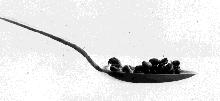These primitive mammals produce a shelled egg like their reptilian ancestors. Only four species exist today: three species of spiny anteater (echidna) and the duckbill platypus. [More]

Marsupials do not produce a shelled egg. The egg, which is poorly supplied with yolk, is retained for a time within the reproductive tract of the mother. The embryo penetrates the wall of the uterus. The yolk sac provides a rudimentary connection to the mother's blood supply from which it receives food, oxygen, and other essentials. However, this interface between the tissues of the uterus and the extraembryonic membranes never becomes elaborately developed, and the young are born in a very immature state.
The photo (courtesy of Dr. Carl G. Hartman) shows 18 newborn baby opossums fitting easily into a teaspoon.
Despite their tiny size, they are able to crawl into a pouch on the mother's abdomen, attach themselves to nipples, and drink milk from her mammary glands.
Marsupials are still abundant in Australia, but only the opossum is found in North America.
In placental mammals, the extraembryonic membranes form a placenta and umbilical cord, which connect the embryo to the mother's uterus in a more elaborate and efficient way. The blood supply of the developing fetus is continuous with that of the placenta. The placenta extracts food and oxygen from the uterus. Carbon dioxide and other wastes (e.g., urea) are transferred to the mother for disposal by her excretory organs.
Humans are placental mammals.
| Link to an illustrated discussion of pregnancy in humans. |
 The embryos of reptiles, birds, and mammals produce 4 extraembryonic membranes, the
The embryos of reptiles, birds, and mammals produce 4 extraembryonic membranes, the